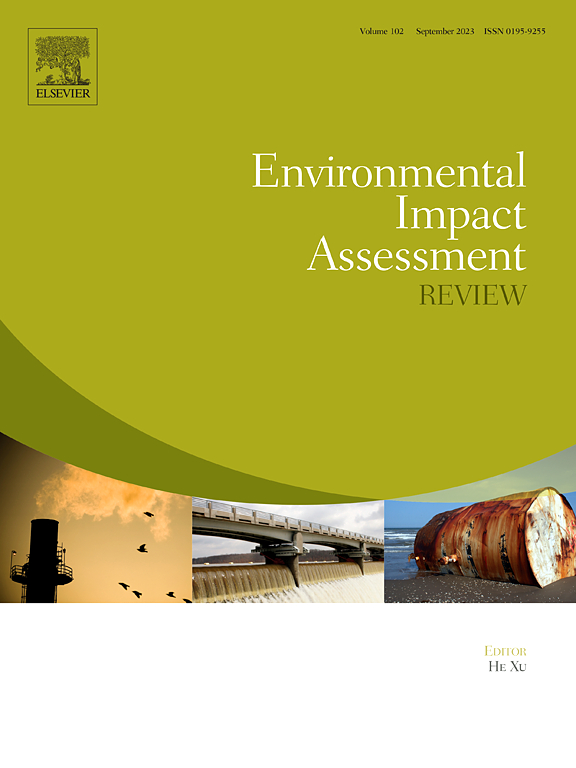Assessing inter-industrial ecosystem service flows and economic benefits of sponge city: A comprehensive input-output analysis
IF 9.8
1区 社会学
Q1 ENVIRONMENTAL STUDIES
引用次数: 0
Abstract
Sponge cities, crucial components of urban eco-infrastructure, play a vital role in mitigating urban waterlogging, enhancing water resource management, and improving ecosystem resilience. However, the economic and ecosystem services benefits of low-impact development (LID) facilities in cities remain unclear. This study classified sponge city facilities as distinct subsectors within an input-output framework and develops a partial closure model to assess their economic and ecological impacts during construction and operation phases. Additionally, an ecological satellite account for carbon sinks, SS removal and water conservation is compiled to quantify the economic value of ecosystem services. Using Xining City's sponge city project as a case study, the findings reveal that the primary sector benefits most from water conservation (34.58 %), while government consumption (58.9 %) is the largest indirect beneficiary of suspended substance (SS) removal and carbon sequestration, reflecting the public good nature of environmental benefits. Sponge city construction stimulates economic activity, with total inputs exceeding four times the direct investment, driving growth in hidden sectors such as food processing, finance, and energy distribution. Additionally, the carbon sequestration from sponge city facilities offsets construction-related emissions within 4.07 years, though only 41.78 % of maintenance-phase emissions are balanced by carbon sinks, emphasizing the need for long-term sustainability measures. These results highlight sponge cities' unique role in economic restructuring, distinguishing them from traditional infrastructure. The study provides a framework for integrating ecological and economic indicators, supporting evidence-based urban planning and the transition toward a sustainable, eco-economic development model.
海绵城市产业间生态系统服务流与经济效益评价:综合投入产出分析
海绵城市是城市生态基础设施的重要组成部分,在缓解城市内涝、加强水资源管理、提高生态系统恢复能力等方面发挥着重要作用。然而,城市低影响开发(LID)设施的经济和生态系统服务效益尚不清楚。本研究在投入产出框架中将海绵城市设施划分为不同的子行业,并建立了部分封闭模型,以评估其在建设和运营阶段的经济和生态影响。此外,还编制了碳汇、SS去除和水资源保护的生态卫星账户,以量化生态系统服务的经济价值。以西宁市海绵城市项目为例,研究结果表明:第一产业从节约用水中获益最多(34.58%),而政府消费(58.9%)是环境效益的最大间接受益者,体现了环境效益的公共性。海绵城市建设拉动了经济活动,总投入超过直接投资的4倍,带动了食品加工、金融、能源配送等隐性行业的增长。此外,海绵城市设施的碳汇在4.07年内抵消了与建设相关的碳排放,尽管只有41.78%的维护阶段的碳汇被平衡,强调了长期可持续性措施的必要性。这些结果突出了海绵城市在经济结构调整中的独特作用,将其与传统基础设施区分开来。该研究提供了一个整合生态和经济指标的框架,支持循证城市规划和向可持续的生态经济发展模式过渡。
本文章由计算机程序翻译,如有差异,请以英文原文为准。
求助全文
约1分钟内获得全文
求助全文
来源期刊

Environmental Impact Assessment Review
ENVIRONMENTAL STUDIES-
CiteScore
12.60
自引率
10.10%
发文量
200
审稿时长
33 days
期刊介绍:
Environmental Impact Assessment Review is an interdisciplinary journal that serves a global audience of practitioners, policymakers, and academics involved in assessing the environmental impact of policies, projects, processes, and products. The journal focuses on innovative theory and practice in environmental impact assessment (EIA). Papers are expected to present innovative ideas, be topical, and coherent. The journal emphasizes concepts, methods, techniques, approaches, and systems related to EIA theory and practice.
 求助内容:
求助内容: 应助结果提醒方式:
应助结果提醒方式:


